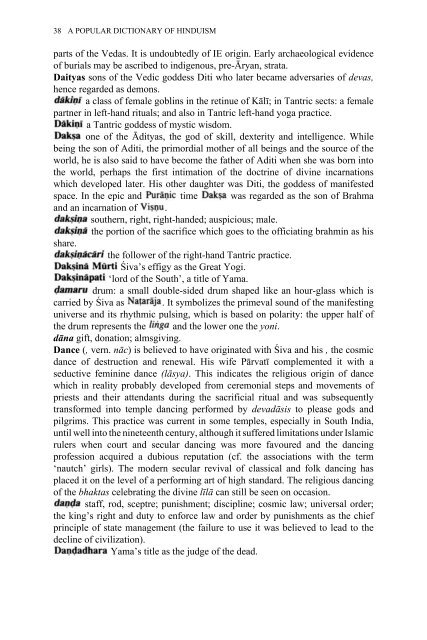Create successful ePaper yourself
Turn your PDF publications into a flip-book with our unique Google optimized e-Paper software.
38 A POPULAR DICTIONARY OF HINDUISM<br />
parts <strong>of</strong> the Vedas. It is undoubtedly <strong>of</strong> IE origin. Early archaeological evidence<br />
<strong>of</strong> burials may be ascribed to indigenous, pre-Āryan, strata.<br />
Daityas sons <strong>of</strong> the Vedic goddess Diti who later became adversaries <strong>of</strong> devas,<br />
hence regarded as demons.<br />
a class <strong>of</strong> female goblins in the retinue <strong>of</strong> Kālī; in Tantric sects: a female<br />
partner in left-hand rituals; and also in Tantric left-hand yoga practice.<br />
a Tantric goddess <strong>of</strong> mystic wisdom.<br />
one <strong>of</strong> the Ādityas, the god <strong>of</strong> skill, dexterity and intelligence. While<br />
being the son <strong>of</strong> Aditi, the primordial mother <strong>of</strong> all beings and the source <strong>of</strong> the<br />
world, he is also said to have become the father <strong>of</strong> Aditi when she was born into<br />
the world, perhaps the first intimation <strong>of</strong> the doctrine <strong>of</strong> divine incarnations<br />
which developed later. His other daughter was Diti, the goddess <strong>of</strong> manifested<br />
space. In the epic and time was regarded as the son <strong>of</strong> Brahma<br />
and an incarnation <strong>of</strong> .<br />
southern, right, right-handed; auspicious; male.<br />
the portion <strong>of</strong> the sacrifice which goes to the <strong>of</strong>ficiating brahmin as his<br />
share.<br />
the follower <strong>of</strong> the right-hand Tantric practice.<br />
Śiva’s effigy as the Great Yogi.<br />
‘lord <strong>of</strong> the South’, a title <strong>of</strong> Yama.<br />
drum: a small double-sided drum shaped like an hour-glass which is<br />
carried by Śiva as . It symbolizes the primeval sound <strong>of</strong> the manifesting<br />
universe and its rhythmic pulsing, which is based on polarity: the upper half <strong>of</strong><br />
the drum represents the and the lower one the yoni.<br />
dāna gift, donation; almsgiving.<br />
Dance (, vern. nāc) is believed to have originated with Śiva and his , the cosmic<br />
dance <strong>of</strong> destruction and renewal. His wife Pārvatī complemented it with a<br />
seductive feminine dance (lāsya). This indicates the religious origin <strong>of</strong> dance<br />
which in reality probably developed from ceremonial steps and movements <strong>of</strong><br />
priests and their attendants during the sacrificial ritual and was subsequently<br />
transformed into temple dancing performed by devadāsis to please gods and<br />
pilgrims. This practice was current in some temples, especially in South India,<br />
until well into the nineteenth century, although it suffered limitations under Islamic<br />
rulers when court and secular dancing was more favoured and the dancing<br />
pr<strong>of</strong>ession acquired a dubious reputation (cf. the associations with the term<br />
‘nautch’ girls). The modern secular revival <strong>of</strong> classical and folk dancing has<br />
placed it on the level <strong>of</strong> a performing art <strong>of</strong> high standard. The religious dancing<br />
<strong>of</strong> the bhaktas celebrating the divine līlā can still be seen on occasion.<br />
staff, rod, sceptre; punishment; discipline; cosmic law; universal order;<br />
the king’s right and duty to enforce law and order by punishments as the chief<br />
principle <strong>of</strong> state management (the failure to use it was believed to lead to the<br />
decline <strong>of</strong> civilization).<br />
Yama’s title as the judge <strong>of</strong> the dead.


















